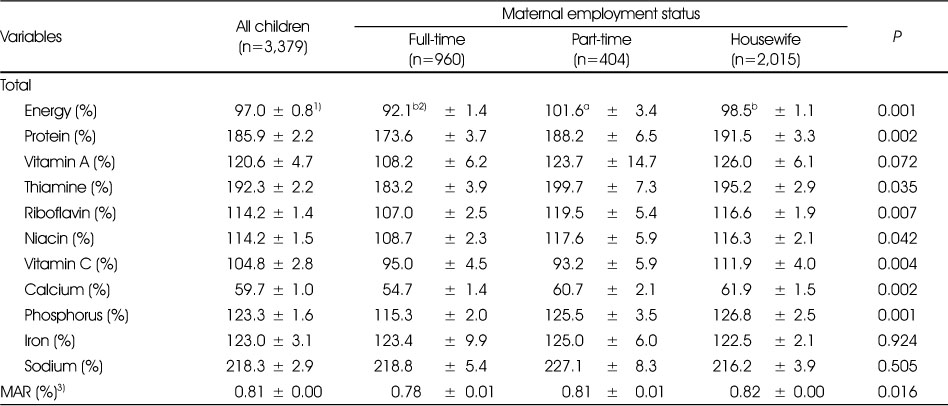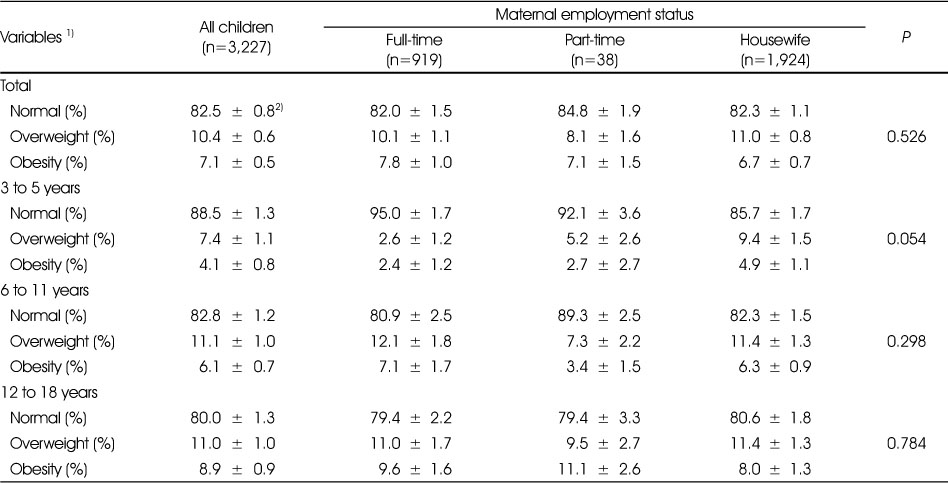References
1. Statistics Korea. Ministry of gender equality and family [Internet] Statistics Korea; 2018. cited 2019 May 29. Available from:
http://kostat.go.kr.
2. Song YJ. Changes in parental time spent with children. Korea J Popul Stud 2011;34(2):45–64.
4. Oh SH, Hyun WJ, Lee HM, Park HR, Lim HJ, Song KH. A study on the stress and the dietary habits of elementary school children by mother's employment status. Korean J Community Nutr 2010;15(4):498–506.
5. Lee YG, Lee MS, Lee MJ, Kim JH, Jung HY, Park EJ, et al. Nutrition through the life cycle 4th edth ed. Paju: Yangseowon; 2015. p. 199. p. 219. p. 285.
6. Korea Centers for Disease Control & Prevention. Korea national health & nutrition examination survey 5th ed (2013–2015)th ed. Daejeon: Minisrty of Health and Welfare; 2018.
7. Chung SJ, Lee YN, Kwon SJ. Factors associated with breakfast skipping in elementary school children in Korea. Korean J Community Nutr 2004;9(1):3–11.
8. Crepinsek MK, Burstein NR. Maternal employment and children's nutrition 1st edth ed. Abt Associates Inc; 2004.
9. Johnson RK, Smiciklas-Wright H, Crouter AC. Effect of maternal employment on the quality of young children's diets: The CSFII experience. J Am Diet Assoc 1992;92(2):213–214.
10. Johnson RK, Smiciklas-Wright H, Crouter AC, Willits FK. Maternal employment and the quality of young children's diets: Empirical evidence based on the 1987–1988 nationwide food consumption survey. Pediatrics 1992;90(2):245–249.
11. Horton S, Campbell C. Wife's employment, food expenditures, and apparent nutrient intake: evidence from Canada. Am J Agric Econ 1991;73(3):784–794.
12. Anderson PM, Butcher KF, Levine PB. Maternal employment and overweight children. J Health Econ 2003;22(3):477–504.
13. Gillespie AH, Achterberg CL. Comparison of family interaction patterns related to food and nutrition. J Am Diet Assoc 1989;89(4):509–512.
14. Lee JW. A comparative study on the nutritional status of the families with working housewives and with non-working ones: Analysis of 2001 Korea national health and nutrition survey data. Korean J Community Nutr 2008;13(5):610–619.
15. Korea Centers for Disease Control and Prevention. 2007 Korean national growth chart [Internet] Korea Centers for Disease Control and Prevention; 2007. cited 2019 May 29. Available from:
http://cdc.go.kr.
16. Min HJ. The life course events and the career interruption among Korean women. Korea J Popul Stud 2011;34(1):53–72.
17. Lee SG. The study of the employment structure and the employment stability of career interrupted women. J Women's Stud 2017;20(1):75–100.
19. Yang SJ. Women's job. Natl Econ 2005;16(9):19–22.
20. Kwon HK. Factors related to the desire of married, “career-interrupted” women to be re-employed. J Korean Home Manag Assoc 2010;28(1):87–98.
22. Kim NJ. Analysis on career-interrupted womens rentry to labor market and maintaining the reemployment. Korean J Ind Relat 2016;26(2):1–27.
23. Koo MS, Hong SU. Married women's return to the workforce: findings from the participants in a reemployment training program. J Korean Home Manag Assoc 2005;23(3):153–167.
24. Kim MH. A study on the actual status of the children's eating behavior by household income level and mother's employment status [Master's thesis] Sungshin Women's University; 2008.
25. Yang HK, Chang UJ, Kim YO, Kim JM, Bae YJ, Kim MJ. A study on preschool-children obesity and physical fitness according to mother's occupational status. Proceedings of 10th Anniversary International Symposium of Korean Community Nutrition Society 2005;10. 08. :72. Seoul.
26. Lee SW, Sung CJ, Kin AJ, Kim MH. A study on nutritional attitude, food behavior and nutritional status according to nutrition knowledge of Korean middle school students. Korean J Community Nutr 2000;5(3):419–431.
27. Jung EH. Smoking status and dietary habits of middle school students. Korean J Community Nutr 2002;7(1):14–22.
28. Jung EH. The effect of working mother's on the dietary behavior of middle and high school students. Korean J Community Living Sci 2004;15(4):79–88.
29. Hwang EY. Comparative study of knowledge of nutrition, dietary habit, dietary behaviors, and food preference for middle school students in West Gyeong Nam [Master's thesis] Silla University; 2007.
30. Woo LJ, Kim SY. Eating behaviors by breakfast frequency of high school students in Yongin area. J Korean Soc Food Sci Nutr 2015;44(1):66–75.
31. The Korean Nutrition Society. 2015 KDRIs 8th revisionth ed. Seoul: The Korean Nutrition Society; 2015.
32. Bae YJ. Evaluation of nutrient intake and meal variety with breakfast eating in Korean adolescents: analysis of data from the 2008~2009 national health and nutrition survey. Korean J Community Nutr 2013;18(3):257–268.
33. Yeoh YJ, Yoon J, Shim JE. Relation of breakfast intake to diet quality in Korean school-aged children: analysis of the data from the 2001 national health and nutrition survey. Korean J Community Nutr 2009;14(1):1–11.
34. Wang SG. Prevalence of obesity, food habits, and daily nutrient intakes of 4th grade elementary school students in Daejeon. Korean J Human Ecol 2007;16(3):631–642.
35. Son Y, Kim HJ. A study on the eating habits, nutrition and dietary fiber intakes of teenagers in Gyeong-nam areas. Korean Home Econ Educ Assoc 2005;17(4):1–26.
36. Lee JS, Lee MH, Kwon TB, Ju JS. A study on the concentration of serum lipids and its related factors of persons over 40 years old in Whachon area, Kang-Won Do. Korean J Nutr 1996;29(9):1035–1041.
37. Lee JY, Lee SY. A comparative study on nutrition knowledge, eating behavior and nutrient intake for students at elementary schools with and without nutrition education program. J East Asian Soc Diet Life 2004;14(6):561–567.
38. Kim JH. A study on nutritional status and serum lipid levels according to obese index of apartment complex in Seoul [master's thesis] Seoul National University; 1993.
39. Shin EK, Lee JH, Lee YK, Lee HS. Effect of short-term nutrition education camp on food and nutrient intakes of obese children. J Korean Soc Food Sci Nutr 2005;34(7):987–999.
40. Shim JE, Paik HY, Moon HK. Breakfast consumption pattern, diet quality and health outcomes in adults from 2001 national health and nutrition survey. J Nutr Health 2007;40(5):451–462.
41. Kim SH, Kim MH, Choi MK, Kim MH. Nutritional knowledge and dietary behavior of middle school students according to their mother's employment status. J Korean Soc Food Cult 2018;33(3):236–242.
42. Han JS, Kim JH. Calcium intake and cognition on calcium of adolescents in Busan area. J Korean Soc Food Sci Nutr 2002;31(6):1026–1034.
43. Cho EA, Lee SK, Heo GJ. Snack consumption behaviors and nutrition knowledge among elementary school students in Siheung-si. Korean J Community Nutr 2010;15(2):169–179.
44. Kim SA, Lee BH. Relationships between the nutrient intake status, dietary habits, academic stress and academic achievement in the elementary school children in Bucheon-si. Korean J Nutr 2008;41(8):786–796.
45. Kim YJ, Choi YJ, Kim HS. Factors related to calceneal broadband ultrasound attenuation, anthropometric indexes and nutrient intakes among elementary school children in Chungnam. Korean J Community Nutr 2013;18(4):312–323.
46. Choi MK, Kim MH, Lee YS, Cho HK, Kim KH, Lee BB. Relation between obesity indices and, nutritional knowledge, nutritional status and blood parameters in obese middle - school students. J Korean Soc Food Sci Nutr 2005;34(2):181–189.
47. Han JS, Kim JH. Calcium intake and cognition on calcium of adolescents in Busan area. J Korean Soc Food Sci Nutr 2002;31(6):1026–1034.
48. Kim SD, Yun ES, Chang MS, Park YA, Jung SO, Kim DG. Survey of daily caffeine intakes from children's beverage consumption and the effectiveness of nutrition education. J Korean Soc Food Sci Nutr 2009;38(6):709–720.
49. Jung SY. Effects of maternal employment on adolescents' overweight and obesity. J Korean Soc Child Welf 2013;41:39–66.
50. Lee YS, Lim HS, Jang NS, An HS, Kim CI, Kim GN, et al. Nutrition through the life cycle 4th edth ed. Paju: Kyomunsa; 2017. p. 195–233.






